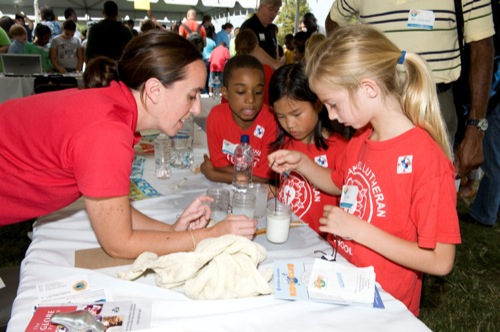Written by John Ohab. Reposted with permission from the Science for Citizens blog.
As summer comes to a close, a young person’s fancy may turn to fretting at the thought of being cooped up in a classroom. But for fans of science and nature—and by that we mean kids who like to watch clouds, hunt mushrooms, prowl around graveyards, and check out what gets squashed on the side of the road—fall need not signal the end of fun.
To keep young minds entertained as well as enlightened, we recommend the following 10 back-to-school projects for student citizen scientists. Teachers and parents, please note: Many of these programs provide materials around which you can build lessons. And there are lots more where these came from. Visit our Project Finder for a full list of citizen science projects for primary and secondary school students.
World Water Monitoring Day: World Water Monitoring Day is an international program that encourages citizen volunteers to monitor their local water bodies. An easy-to-use test kit enables everyone from children to adults to sample local water bodies for basic water quality parameters: temperature, acidity (pH), clarity (turbidity), and dissolved oxygen. Though World Water Monitoring Day is officially celebrated on September 18, the monitoring window is extended to cover the period from March 22 (World Water Day) until December 31. Check out what one of our members said about the project.
School of Ants: Join North Carolina State University researchers in a citizen-scientist driven study of the ants that live in urban areas, particularly around homes and schools. Collection kits are available to anyone interested in participating. Teachers, students, parents, kids, junior-scientists, senior citizens and enthusiasts of all stripes are involved in collecting ants in schoolyards and backyards using a standardized protocol so that project coordinators can make detailed maps of the wildlife that lives just outside their doorsteps.
The Albedo Project: Wherever you are – anywhere in the world – on September 23th, contribute to science by taking a photo of a blank white piece of paper, outside in the sun, between 4:00 and 7:00 pm local time. Your photo will used to to help students measure how much of the sun’s energy is reflected back from the Earth — our planet’s “albedo.” It’s one way scientists can monitor how much energy – and heat – is being absorbed by our planet.
Students’ Cloud Observations On-Line (S’COOL): Report your observations of clouds—their shapes, height, coverage, and related conditions—so that NASA scientists can compare them with data from weather satellites passing over your area. Tutorials and observing guides are available for students. For teachers, the program provides lesson plans, charts, and advice on related educational standards.
Tracking Climate in Your Backyard: This project teaches volunteer meteorologists aged 8 to 12 about the scientific process by enlisting them in the collection of weather data in their communities. Download free support material and curriculum.
Physics Songs: Physics Songs aims to be the world’s premier website devoted to collecting and organizing all songs about physics. It is managed by Walter F. Smith, Professor of Physics at Haverford College. Songs about physics can help students to remember critical concepts and formulas, but perhaps more importantly they communicate the lesson that physics can be fun.
Tracking Climate in Your Backyard: This project teaches volunteer meteorologists aged 8 to 12 about the scientific process by enlisting them in the collection of weather data in their communities. Download free support material and curriculum.
Gravestone Project: With Halloween less than two months off, here’s an appropriate activity for young citizen scientists: Map the location of cemeteries near you using a GPS device. Then, following instructions on the project website, measure the rate at which marble gravestones erode at each site due to weathering. You’ll be helping researchers determine changes in the acidity of rainfall between locations and over time.
Celebrate Urban Birds: Join the Cornell Lab of Ornithology and citizen ornithologists around the country in studying the presence and behavior of 16 species of birds in urban habitats. You’ll stake out an area about half the size of a basketball court and then spend 10 minutes on a designated day reporting on the presence or absence of these resident and migratory birds. A kit including posts and stickers is available from Cornell—or you can download most of the supporting materials from the website.
Great Lakes Worm Watch: What red-blooded student scientist could resist a hunt for earthworms? This program is limited to the critters in Minnesota, which, being non-native worms imported by early Europeans, are presumed to be changing the native forests of the region. Worm Watch needs volunteers to collect specimens; record habitat data in farmland, pastures, and parks; and conduct soil surveys where these “exotic” worms are found.
Stellar Classification Online Public Exploration: SCOPE needs citizen scientists to classify stars based on images of their spectra. After a quick registration and online tutorial, you can examine your first stellar spectrum and compare it to the “light signature” of well-known reference stars. Check out what high school student Eli Moorhouse wrote about his recent adventures working on SCOPE.









